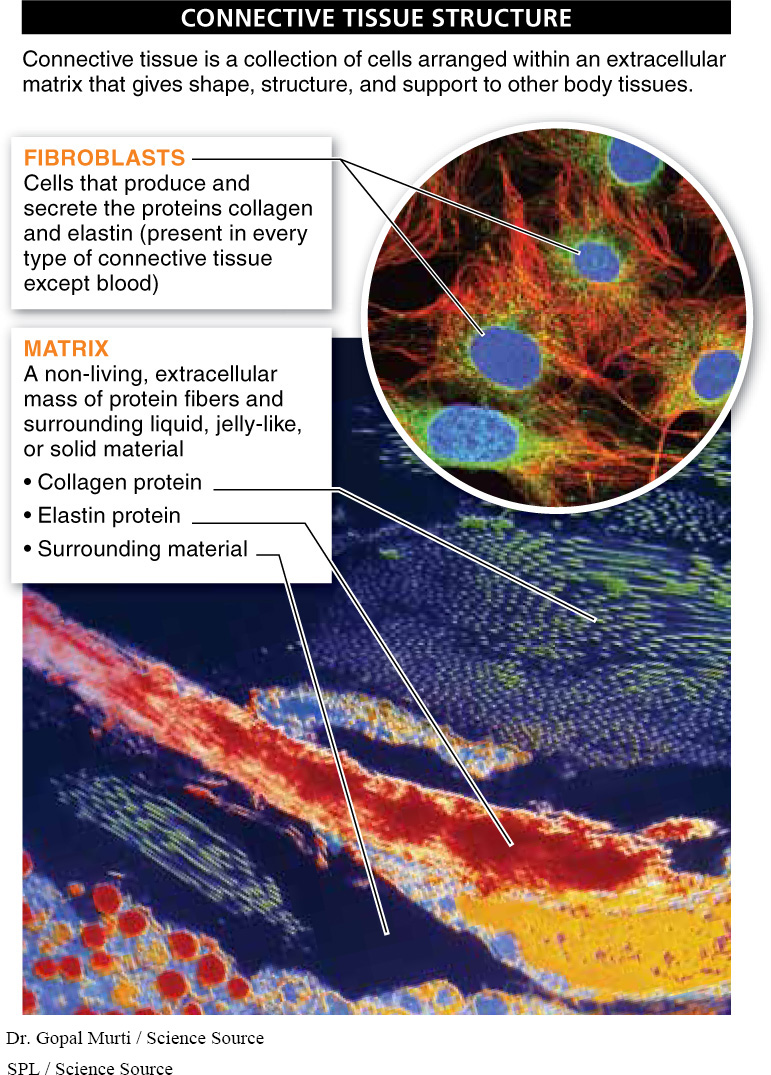20.2 Connective tissue provides support.


Connective tissue is usually the most abundant type of tissue in an animal. Most activities rely heavily on connective tissue, often in conjunction with muscle tissue. Playing tennis, for example, relies on blood to deliver oxygen to muscle, tendons that connect muscles to bones, and cartilage that cushions the joints (FIGURE 20-4). (Collagen from the intestines of cows is even used as a material for producing the strings in some tennis rackets.) Connective tissue is sometimes called “cellular glue,” because it holds cells together and, as bone and cartilage, for example, gives shape, structure, and support to other tissues, structures, and organs throughout the body.
Regardless of the function it performs or the form it takes, all connective tissue consists of cells that are embedded in matrix—
A type of tissue called connective tissue proper functions much like the body’s packing material. It can be loosely or densely packed. In loose connective tissue, the cells are in a semi-
Dense connective tissue is stronger than loose connective tissue. It also has collagen as its chief matrix component, but it has many more tightly packed collagen fibers than loose connective tissue. Examples of dense connective tissue include tendons, which connect muscle to bone, and ligaments, which bind bone to bone. A sprained ankle is a common injury in which a twisting of the ankle overstretches and sometimes tears part of a ligament in the foot.
Q
Question 20.1
What is a sprained ankle?
796
The second type of connective tissue, called special connective tissue, differs from connective tissue proper in that it is rigid or liquid. Bone, cartilage, and blood (see Figure 20-6) are examples.
In bone, he mineral calcium is incorporated into the extracellular matrix, which then hardens into a solid material. Bones can give significant protection to the body (the skull protects the brain, the ribs protect the lungs and heart) or can provide structural support, as the backbone does.

Cartilage, a dense connective tissue with an extracellular matrix rich in collagen, elastin, and proteins bound to long carbohydrate chains, has a hardness between that of bone and that of tendons. Strong, but also flexible, cartilage is found in the ears and the tip of the nose in humans, and it cushions the bones in joints throughout the body. In some organisms, including sharks, the entire skeleton is made of cartilage.
Blood differs from the other types of connective tissue described so far because it has a liquid extracellular matrix. This liquid matrix, called plasma, is made up mostly of water, but also contains dissolved proteins, sugars, and other molecules. Blood cells, including red blood cells and white blood cells, as well as the cellular fragments called platelets (see Chapter 21), are suspended within plasma as they transport gases and other substances throughout the body.
All connective tissues in the body, as we’ve seen, have essentially the same structure: cells embedded within an extracellular matrix that may be solid, soft and flexible, or fluid. An inflammation or malfunction in connective tissue is the cause of many diseases with widespread effects, including scleroderma and Marfan syndrome. The most common type of arthritis, osteoarthritis, results from the breakdown of connective tissue, usually the cartilage, around joints. The reduced cushioning often leads to inflammation of tissue around the joint, with stiffness and pain, and is commonly treated with anti-
Q
Question 20.2
The most common form of arthritis is called “wear and tear” arthritis. Why?
797
TAKE-HOME MESSAGE 20.2
The most abundant type of tissue in most animals is connective tissue. Connective tissue is a collection of cells embedded within an extracellular matrix, usually containing collagen, that holds the cells together and gives shape, structure, and support to other body tissues. Examples of connective tissue include tendons, ligaments, fat, blood, bone, and cartilage.
Connective tissue consists of cells embedded in a non-